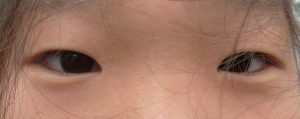Squint Eye in Babies
Squint eye in babies occurs when one eye turns inward, outward, upward or downward and another eye looks forward normally. It is also called Strabismus in medical terms.
This indicates that the weak eye has a poor vision. If it continues further then the child could develop a ‘lazy eye’. It is an eye disorder where there is lack of coordination between the brain and the eye movement.

The experts say, squint eye in babies normally occurs when there is:
- a family history of squint,
- vision problem,
- nerve or brain problem,
- a tumour in the eye, or
- any other developmental delays.
If you notice any symptoms like closing eyes when focusing an object and squint that doesn’t seem to go away then talk with local opticians or GP.

However, there is also a ‘fake squint’ that exists which is termed as Pseudostrabismus. Mostly in Asian children, the fake squint tend to be quiet visible.
The reason is due to the broad flat nasal bridge in Asian children that lead the skin to fold at the inner corner of the eyelid.
This makes the white surface of the eye to become less exposed. As a result, the cross-eye or ‘fake squint’ like appearance occurs in babies.
However, it goes away when the facial features mature in the future. So, no medical treatment is necessary.
The early diagnosis and treatment of Strabismus are quite essential because when the child reaches 4 years, it will be difficult to treat the poor vision of the eyes.
The parents should be alert if their babies older than 3 months has a squint eye that comes and goes. Once the opticians investigate if it’s Strabismus or Pseudostrabismus, the treatment process starts thereafter.
The treatments include:
- Eye exercises for the eye muscle movement
- Patches to the normal eye to let the weak eye muscle to work
- Glasses if the squint caused by child’s eyesight
- Eye surgery only if above treatments will not help
Therefore, it’s better to book an appointment with your GP or local optician as soon as you identify these symptoms in your babies.
Early treatment corrects the vision of the eye as well as the squint. So, it’s better to have a routine checkup every 6-9 months to avoid any eye problem later.
 Copyright protected by Digiprove © 2017
Copyright protected by Digiprove © 2017